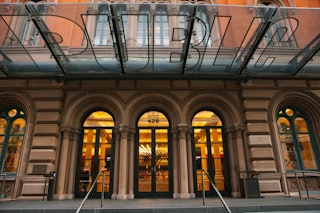‘Off-Broadway’ refers to the smaller venues, primarily located outside the Broadway Theatre District, which contain between 100 and 499 seats. In 1974, Off-Broadway actors went on strike over pay and working conditions. It was during this strike that Actors’ Equity increased the maximum capacity of Off-Broadway theaters from 299 to 499, enabling the sector to fund higher-quality productions and maximize profits while at the same time paying actors a fairer wage.
There are over 80 Off-Broadway theaters throughout Manhattan, with notable examples including Playwrights Horizons, Manhattan Theatre Club, and the Public Theater. Each year, the Off-Broadway community’s achievements are recognised at the Obie Awards, which have championed new work and boundary-pushing theater since the 1950s. Recent winners have included Lin-Manuel Miranda, Cole Escola, and Lynn Nottage. Recent hit Off-Broadway productions include Little Shop of Horrors at the Westside Theatre, The Play That Goes Wrong, and Perfect Crime. The latter is the longest-running play in Broadway and Off-Broadway history combined.
It’s important to note that Off-Broadway doesn’t simply mean Broadway done on a smaller scale. These venues are far more inclined to take risks and stage experimental, edgy works that would struggle to find an audience in the more tourist-driven Broadway market. This sense of creative freedom has enticed many major celebrities to star in Off-Broadway shows, including the likes of Tom Hanks, who is co-writing and starring in This World of Tomorrow at the Shed later this year; Adam Driver in Hold On to Me Darling at the Lucille Lortel Theatre; and John Krasinski in Angry Alan at Studio Seaview. And it’s not just actors, visionary film studio A24 has also staked its own claim in the Off-Broadway scene, buying the 100-year-old Cherry Lane Theatre for $10 million in 2023. And Audible, the audiobook giant, has had an ongoing partnership with the Minetta Lane Theatre in Greenwich Village since 2018, showcasing plays, comedy, and other genres of theater as part of its expansion.
Ticket pricing is one of the most significant differentiators between Broadway and Off-Broadway theaters. Most Off-Broadway venues pride themselves on making theater more accessible to all, offering schemes for students, veterans, and seniors where tickets can be purchased for as little as $10 or even free of charge. Even shows with Hollywood actors like Hugh Jackman, who starred in Sexual Misconduct of the Middle Classes at the Minetta Lane Theatre earlier this year, saw the vast majority of tickets available for $35 and under. This is significantly lower than the average cost of a Broadway ticket, which currently stands at $129.12 (according to the latest research by the Broadway League).
We've curated a list of discount off-Broadway tickets for your convenience.

